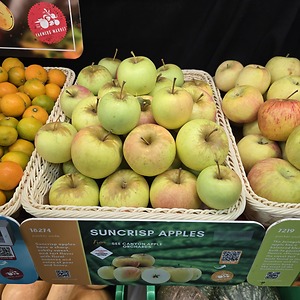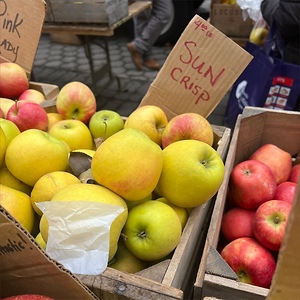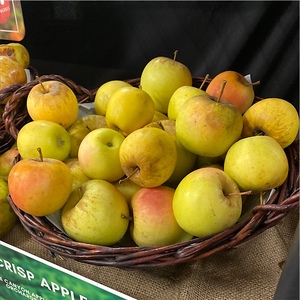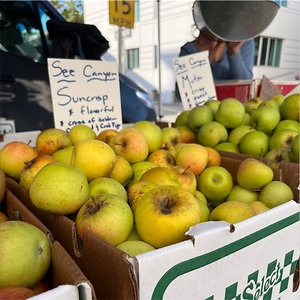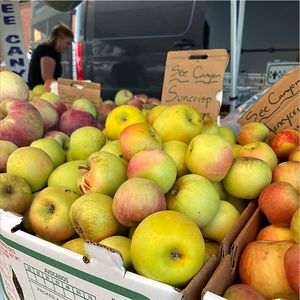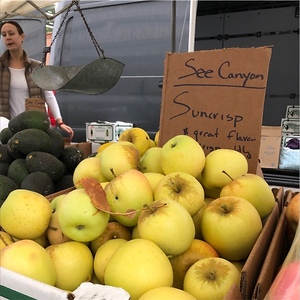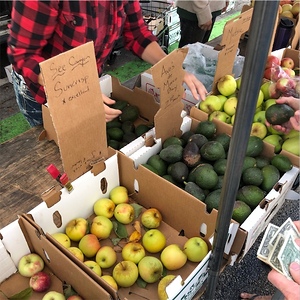

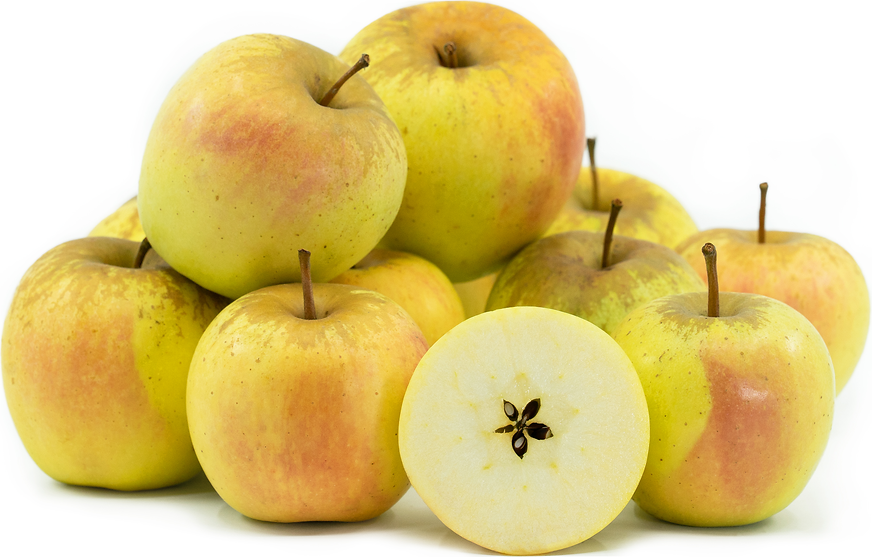
Suncrisp Apples
Estimated Inventory, lb : 0
Description/Taste
Suncrisp apples are a medium to large varietal, averaging 7 to 8 centimeters in diameter, and are larger than a golden delicious with a round to conical appearance, slightly ribbed and tapered towards a flattened base. The apple’s skin is thick, chewy, and taut with a faint sheen, often covered in large patches of brown russet around the stem cavity. The skin also has a yellow-green hue, showcasing patches of dull, red-orange blush with raised, rough, and russeted lenticels giving the surface a textured feel. Underneath the skin, the ivory to white flesh resists browning when sliced and is firm, dense, and crisp. The flesh is also aqueous and coarse, encasing a small central cavity filled with tiny black-brown seeds. Suncrisp apples have high sugar and acidity, creating a sharp, subtly sweet, and tart flavor with floral nuances and notes of pear and honey. As the apple is kept in storage, its taste will mellow, developing a sweeter, mildly tangy complexity with caramel and aniseed undertones.
Seasons/Availability
Suncrisp apples are available in the late fall.
Current Facts
Suncrisp apples, botanically classified as Malus domestica, are a modern American variety belonging to the Rosaceae family. The cultivar was developed in the late 20th century through Rutgers University and was selected as an improved golden delicious type, growing on trees that can reach 6 to 7 meters in height. Suncrisp apples, sometimes written as SunCrisp, are a late-season variety, ripening approximately one week after golden delicious apples, and are favored for their extended storage capabilities. The apples can be kept up to six months in professional cold storage, and the flavor mellows and sweetens with age, developing a complexly flavored fruit. Suncrisp apples also have golden yellow skin that does not bruise easily, and the flesh is crisp and firm, browning slowly, allowing it to be used in a wide array of fresh preparations. In the modern-day, Suncrisp apples are not grown commercially due to their russeted nature, a trait considered unfavorable among common consumers, but the variety is sold directly to apple enthusiasts through specialty orchards.
Nutritional Value
Suncrisp apples are a source of fiber to regulate the digestive tract and potassium to balance fluid levels within the body. The apples also provide vitamin C to strengthen the immune system while reducing inflammation, vitamin B6 to maintain amino acid levels within the bloodstream, quercetin to contribute anti-inflammatory and antioxidant-like properties, and contain other nutrients, including vitamin K, copper, boron, calcium, and manganese.
Applications
Suncrisp apples have an initially tart flavor that mellows with storage, well suited for fresh and cooked preparations. The apples can be consumed straight, out of hand, and the chewy, thick skin can be peeled or left intact, depending on preference. Suncrisp apples can also be chopped into slaws, mixed into fruit bowls, tossed into salads, or used as a fresh topping for waffles, parfaits, and oatmeal. The apple’s tangy flavor complements the rich taste of caramel when dipped as candied fruit, and the flesh is commonly served with cheeses on charcuterie plates. Suncrisp apples are also layered into sandwiches for added crunch, sliced and dipped into nut butter, or pressed into ciders, juices, and sparkling beverages. In addition to fresh preparations, Suncrisp apples have a dense, crisp texture that holds their shape in baked dishes. The apples can be incorporated into pies, cakes, cobbler, tarts, and crisps, or simmered into apple butter, sauce, jams, and chutney. Try roasting Suncrisp apples and serving with pork for a savory main dish or baking the apples whole and stuffing with spices and nuts as a healthy dessert. Suncrisp apples pair well with nuts such as pecans, Marcona almonds, and walnuts, cheeses including blue, cheddar, goat, and brie, spices such as cinnamon, ginger, cloves, and cardamom, and meats including pork, poultry, and turkey. Whole, unwashed Suncrisp apples will keep 1 to 3 months when stored in a plastic bag in the refrigerator’s crisper drawer. The apples can be kept for 5 to 6 months in professional cold storage when placed in a plastic bag to prevent moisture loss.
Ethnic/Cultural Info
Suncrisp apples are Ohio farmer Mitch Lynd’s favorite variety. Mitch Lynd is one of the leading apple experts in the state, partnering with his two brothers to run the Lynd Fruit Farm. Apple farming has been the lifeblood of Lynd’s family lineage, with his ancestors planting their own orchards back in the mid-1800s, and the tradition has continued with the Lynd Fruit Farm, spanning across 700 acres of land. Out of the 700 acres, 400 acres are planted with apples. Mitch Lynd’s passion for apples also extends beyond his farm, as he helped co-found the Midwest Apple Improvement Association, a collaborative of over 500 members that discusses everything related to apple production. Apple growers across the Midwest look to Lynd’s advice for what apple varieties are long storing, firm-fleshed, and suitable for specific Midwest climates. Lynd represents himself as an apple ambassador, promoting unusual apple varieties, including Suncrisp apples, that may not be commercially popular but are successful through farm-sold offerings. Suncrisp apples are a part of the orchards on Lynd’s farm that are open to the public and are sold as a specialty u-pick variety, favored by visitors for their unusual tart flavor and dense crunch. While consumers may overlook these apples in grocery stores due to their imperfections, Suncrisp apples are successful at Lynd’s farm as the farm staff sells the apple’s story and flavor, giving the visitors a sensory experience to appreciate the variety.
Geography/History
Suncrisp apples were developed by Dr. Fred Hough and Catherine Bailey at the Rutgers Horticultural Research Farm in New Brunswick, New Jersey. The variety was created from a cross between cortland and cox’s orange pippin apples, known as NJ303955, and the resulting apple from this cross was bred with golden delicious in 1963. The new seedling was selected and planted at the Rutgers Fruit Research and Extension Center in Cream Ridge, New Jersey, in 1971 and was initially known as NJ55. For several years, NJ55 was tested in field trials in Ohio, New York, Massachusetts, Indiana, Illinois, Washington, Oregon, Virginia, and even Belgium and France. The breeders filed a patent for the variety in 1992, and the patent was granted in 1994 under plant patent number 8648, but the patent eventually expired in 2012. NJ55 apples were released to commercial growers in 1994 under the name Suncrisp, and the variety was most successful when grown as a direct-to-customer apple. Today Suncrisp apples are produced on a small scale throughout the United States and are found through farm stands, farmer’s markets, specialty distributors, and some home gardens.
Recipe Ideas
Recipes that include Suncrisp Apples. One
| Neighborfood |
|
Crock Pot Applesauce |
| breathe sweat eat |
|
Healthy and Easy Apple Crisp |
| Washington Post |
|
Apple Sharlotka |



